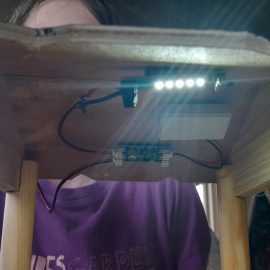
Day 10
The wattage (W) given for an appliance expresses how much power it consumes in an hour. Multiply that by hours of use in a given period and you get watt hours (Wh), which is the amount of power consumed in that period. Easy.
After looking at the labels on all the equipment we have plus furious googling for information on stuff we’re yet to purchase, we relate that information to the story we told of an imaginary but typical busy summer term week and come up with the following power consumption table for our outdoor learning area:
| Unit | Power drawn per hour (W) /per charge (Wh) | Hours of use in a week | or | Times charged from flat to full charge | Weekly power consumption |
| Small Bluetooth speaker | 5 W | 1 | 5 Watts x 1 Hr = 5Wh | ||
| Large Bluetooth speaker | 40 Wh | 1 | 1 x 40 Wh = 40 Wh | ||
| Power tool battery | 24 Wh | 2 | 24 Wh x 2 = 48 Wh | ||
| Smartphone | 2 Wh | 4 | 2 Wh x 4 = 8 Wh | ||
| LED lights (3) inside Steve Shelter* | 36 W | 7 | 36 W x 7 Hrs = 252 Wh | ||
| Laptop computer | 50 W | 3 | 50 W x 3 Hrs = 150 Wh | ||
| 12 volt pump | 24 W | 0.5 | 24 W x 0.5 Hrs = 12 Wh | ||
| 480 light LED string | 12 W | 6 | 12 W x 6 Hrs = 72 Wh | ||
| 12 volt blender** | 240 W | 1 | 240 W x 1 Hr = 240 Wh | ||
| Total: | 827 Wh |
*We don’t have these yet but we plan to have one light giving 1280 lumens, one giving 640 lumens and one 480 lumens. There are several conversion tables online all saying slightly different things. A low average of those suggests our lights draw 18 W, 10 W and 8 W respectively, giving a total of 36 W for an hour of all lights being on.
**Yes, that’s right. As soon as you add fast moving parts (or start heating things up) Watts go through the roof.
So our total power consumption in a week is in the ball park of 827 Wh. We look at available battery sizes. Solar Stu suggests a battery via email. We compare the figures. Whaaaat? The email says nothing about watt hours. The battery he suggests is 140 Amp Hours (Ah).
After educating ourselves a little more we learn that you can calculate watt hours by multiplying amp hours with volts. So 140 Ah 12 V battery has 1680 Wh in it. That’s about double as much as we need in a week, so we have a lot of extra power? Room to grow our activities?
No. To look after your battery, you shouldn’t let its charge fall below 50%. In our case that means that we have 70 Ah (= 840 Wh) of usable battery capacity in the suggested battery. So if we start with a full battery, we can get through this imaginary week without any solar going in, but then that’s it.
This sounds OK. There’s enough capacity to get us through the busy part of the week and the battery can recuperate fully during the lull. Or that’s the plan. Despite the way it seems sometimes, surely any week of the British summer will deliver at least some photons towards Steve’s roof… but how much exactly will we get out of our panel?
More calculations to follow!

